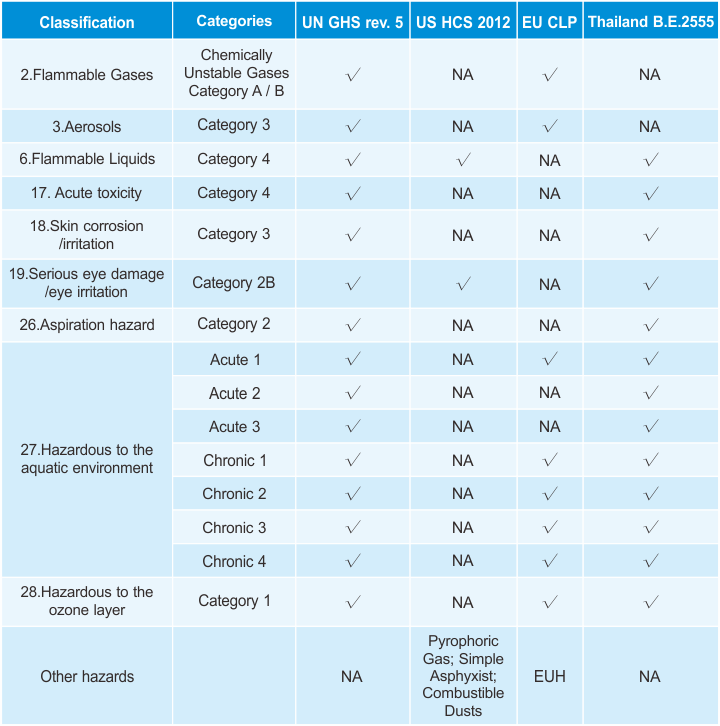The B.E.2555 “Hazard Classifications and Communication System of Hazardous Substances” was issued by the Ministry of Industry of Thailand and then published in the Government Gazette in 2012. The B.E.2555 is also mentioned as Thailand GHS, which adopted the 3rd revised edition of UN GHS (purple book 2009). It introduced GHS classification and communication system into Thailand in 2012.
Scope
The department of Industrial Works (DIW) is leading the implementation of GHS in Thailand. FDA and DOA are in the process of GHS implementation over household/public health use chemicals and agricultural chemicals respectively. Chemicals regulated under other departments/regulations are out of the scope, e.g. pesticide, chemical waste, used electronic device, etc.
Transitional Period
The transitional period for substance and mixture has been listed in the following table for reference.

Highlights
What are the differences of Classification/Building block among Thailand GHS, EU CLP, US HCS 2012 and UN GHS Rev. 5 ?
As the classification and building block are different among Thailand GHS, EU CLP and US HCS, companies which already have CLP and HCS SDS and label could not simply translate them into Thai language. Actually, industries need to re-classify their chemical products according to B.E.2555 and compose SDS and label consequently. The table below shows the different hazards categories among these areas. The differences may also lead to various pictograms, H statements and P statements.

Language
Thai.
CBI
Thailand does not require suppliers filing a claim for exemption. The hazardous composition information is required to be submitted to DIW. The CBI information will be protected. DIW will not release the information to the public.
24hrs emergency telephone number
Thailand does not give a strict local number or 24/7 requirements. However, for hazardous chemicals, it is still necessary to provide an emergency contact in SDS and labels.
P statements
Thailand does not give a selection rule for the precautionary statements on the labels.
Hazardous Classification List
There isn’t a mandatory classification list in Thailand. An advisory classification list can be checked online. Around 500 regulated hazardous substances under the Hazardous Substances Acts are available. When the manufacturers and importers are lacking of data/hazard information, this list could help. It can be searched by CAS#. The website is in Thai language. But the advisory classifications can be understood by the H codes and pictograms. Below is a screenshot of a searching result.
(http://ghs.diw.go.th:8080/GHSThaiUser/jsp/search.jsp)
Other Requirements
For hazardous substances manufactured or imported more than 1 ton per annual, a notification is required to be submitted to DIW according to the B.E.2558. Most required notification data can be picked from the SDS. For non-hazardous chemicals, a full composition is not required. For hazardous chemicals, normally a 100% composition data is required to be submitted to DIW.

